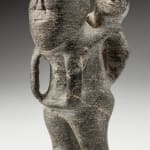-
Artworks
JOHN TIKTAK, R.C.A. (1916-1981) KANGIQLINIQ (RANKIN INLET)
Mother and Child, c. 1964-65stone, 6.75 x 2.25 x 3.75 in (17.1 x 5.7 x 9.5 cm)
signed with artist's disc number, "E1-266".
LOT 109
ESTIMATE: $25,000 — $35,000
PRICE REALIZED: $26,400.00Further images
John Tiktak moved to Rankin Inlet in 1958 to work at the new nickel mine there. He was injured the following year and began to make carvings; by 1962 he...John Tiktak moved to Rankin Inlet in 1958 to work at the new nickel mine there. He was injured the following year and began to make carvings; by 1962 he had taken up carving as a full-time profession. Tiktak is generally considered to be the most important sculptor of the Kivalliq (Keewatin) Region, and was the first Inuit artist to be given a solo exhibition at a public gallery in Canada in 1970.
Mother and Child is a superb important early work by the artist, dating from c. 1964-65, carved probably a year or perhaps two before Tiktak’s most famous work, Mother and Child from 1966 in the Art Gallery of Ontario collection (see Ingo Hessel, Inuit Art, fig. 75 and elsewhere). We specifically mention that work because we see the present Mother and Child as an important precursor to it. Although our example is only one-third the size of the later work, the style and format are almost identical; one might think of the AGO work is a “stretch” version of this wonderful antecedent.
In the early-mid 1960s Tiktak had only just begun to radically simplify and “abstract” the sculptural form of the human body. As we can see he was already keen to open up negative space, but he had not yet invented the round and oval voids that would characterize works from just a few years later (see Lot 33 for a fine example). Tiktak had, however, already invented his trademark facial features, chosen his favourite figural poses, and developed his penchant for depicting the human figure without clothing. This latter decision to remove the amautiq from his subjects means that the figures of children become active participants in his compositions rather than half-hidden appendages. (It also makes us wonder whether the adult figure should always be assumed to be female.)
Mother and Child reminds us of the lovely, probably slightly later example offered at the First Arts December 2020 sale (Lot 110). These two small masterpieces, almost the same size, share a sense of delicacy blended with rugged charm. Bravo, Tiktak.
References: For similar important examples see First Arts Auction, Dec. 2020, Lot 110; George Swinton, Sculpture of the Inuit, (Toronto: McClelland & Stewart, 1972/92), fig. 660-662; George Swinton, Tiktak: Sculptor from Rankin Inlet, N.W.T., (Winnipeg: Gallery One-One-One, University of Manitoba, 1970), cat. cats. 6, 23, 24, 26, 28; Darlene Coward Wight, The Jerry Twomey Collection, (Winnipeg: Winnipeg Art Gallery, 2003), p. 105; Darlene Coward Wight, The Harry Winrob Collection, (WInnipeg: Winnipeg Art Gallery, 2008), p. 109; Toronto-Dominion Bank, The Eskimo Art Collection of the Toronto-Dominion Bank, (Toronto: T-D Bank, 1967), cat. 19. For another important example see First Arts Auction, July 2021, Lot 23.
Provenance
Collection of John and Joyce Price, Seattle, WA.
Join our mailing list
* denotes required fields
We will process the personal data you have supplied in accordance with our privacy policy (available on request). You can unsubscribe or change your preferences at any time by clicking the link in our emails.












